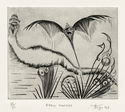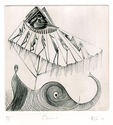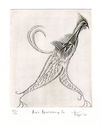
19th, 20th & 21st Century Fine Prints
707-546-7352 · fax 707-546-7924 · web: www.annexgalleries.com · email: artannex@aol.com
Ian Hugo Biography
Ian Hugo
American
1898–1985
Biography
Ian Hugo was born Hugh Parker Guiler in Boston, Massachusetts on February 15, 1898. His childhood was spent in Puerto Rico (a "tropical paradise," the memory of which stayed with him and surfaced in both his prints and his films), and he attended school in Scotland and graduated from Columbia University in New York with degrees in economics and literature. He wouldn't come to art until later in life.
In 1923 Guiler was working with the National City Bank when he met and married novelist and diarist Anais Nin. They moved to Paris the following year. Guiler, finding himself immersed in the world of modern artists and thinkers, and financially supporting his wife's controversial writing career, feared his business associates would not understand his interests in art and music, so he began a second life - as Ian Hugo. It was in the late 1930s that Hugo first began drawing, and when Ian and Anais moved to New York in 1939, he decided to pursue art more formally. In 1940 he delved into engraving and etching at Stanley William Hayter’s Atelier 17, the famed experimental printmaking workshop which Hayter had moved from Paris to New York's New School for Social Research when the war forced many of its participating artists out of Europe.
By 1941 Hugo began producing intaglio prints in earnest, creating surreal images that often accompanied Nin's books and those of other writers who she published through her own press, Gemor Press. He would continue to create imagery for her published works until 1959. For Nin, his unwavering love and financial support were indispensable; Hugo was "the fixed center, core...my home, my refuge" (Sept. 16, 1937, Nearer the Moon, The Unexpurgated Diary of Anais Nin, 1937-1939). A fictionalized portrait of Hugo appears in Philip Kaufman's 1990 film, Henry & June.
By the mid 1940s Hugo had established himself among New York's leading experimental printmakers, and was a member of the Society of American Etchers. In addition to Nin's books, he contributed illustrations for C.L. Baldwin's book opf poetry, "Quinquivara" (1944, Gemor Press). In 1946 he published New Eyes on the Art of Engraving, part of the Outcast Chapbook series published by Alicat Book Shop, which discussed the different types of intaglio printmaking as well as the importance of experimental art.
Responding to comments that viewers saw motion in his engravings, Hugo chose to take up filmmaking. He asked avant-garde cinematographer Alexander (Sasha) Hammid for instruction, but was told, "Use the camera yourself, make your own mistakes, make your own style." What Ian Hugo did was to delve into his dreams and memories. With no specific plan when he began a film, Hugo would collect images, then reorder or superimpose them, finding poetic meaning in these juxtapositions. These spontaneous inventions greatly resembled his engravings, which he described in 1946 as "hieroglyphs of a language in which our unconscious is trying to convey important, urgent messages."
In the underwater world of his film Bells of Atlantis all of the light is from the world above the surface; it is otherworldly, out of place yet necessary. In Jazz of Lights (1954) the street lights of Times Square become in Nin's words, "an ephemeral flow of sensations." This flow that she also calls "phantasmagorical" had a crucial impact on Stan Brakhage who now says that without Jazz of Lights "there would have been no Anticipation of the Night." Hugo lived the last two decades of his life in a New York apartment high above street level. In the evenings, surrounded by an electrically illuminated landscape, he dictated his memoirs into tape recorders and would from time to time polish the large copper panels that had been used to print his engravings from the worlds of the unconscious and the dream.
Though he was a prolific printmaker, and created a sizable body of pioneering art and film, Hugo never pursued art for money. It remained only a passion and an outlet, while his financial career sustained him otherwise. As such, his only marketed art appears to have been accidental, as in the case of the illustrations he created for Anais Nin. Despite this, his work remains an important part of the early American Surrealist movement, as well as an influence on many artists since.
Ian Hugo died in Manhattan, New York City on January 7, 1985. His work is held in the collections of the Smithsonian American Art Museum, Wash. D.C.; the Museum of Modern Art, NY; the Brooklyn Museum, NY; the National Gallery of Art, Wash. D.C.; New York Public Library, NY; the Metropolitan Museum of Art, NY; Rose Art Museum, Brandeis University, MA; and the British Museum of Art, London, among others.







